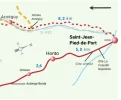Warning: The following should only be read by nerds that own a copy of Brieley's guide to the CF. It os something I wrote up long ago but maybe never posted.
John Brieley's camino guides supply the distances between end points on his stages and also an equivalent distance to help you judge how long it may take walk the stage. His equivalent distance accounts for the slowing of your pace walking uphill. I will try to explain what is happening with this. Let's start with
Wikipedia's article on Naismith's rule.
Put into the metric system this is approximately "Allow one hour for every 5 km forward, plus an additional hour for every 600 m of ascent" or equivalently "Allow 12 min for every 1 km forward, plus an additional 10 min for every 100 m of ascent."
So, by this rule (really an approximation), if you walk 20 km forward while gaining 400 m of cumlative elevation you could expect the amount of walking time on the route (for fit 5 kph walkers) to take ( 20 km x 12 min / km ) + ( 400 m x 10 min / 100 m ) = 240 min + 40 min = 280 min (or 4 hr and 40 min).
Walking at the fit hiker's 5 kph pace for that much time on a level trail you would walk 23.3 km and that is the Naismith's rule equivalent level distance. So, to estimate how much time it would take to walk that route for someone who only walked at a 3 kph pace, you would expect a walking time of ( 23.3 km / 3 km/hr ) = 7.766666667 hr or 7 hr and 47 min.
Using the distance of 20 km the above arithmetic is easier to read but if the distance were the 20.6 km (12.8 miles) that
Brierley claims is the distance for the Astorga to Rabanal section of the camino we would expect a Naismith 5 kph pace to finish in (20.6*12)+40 = 287.2 minutes (4 hours, 47 minutes or 4:47). The Naismith equivalent level distance would be how far a person could walk in 287.2 minutes covering 1 km every 12 minutes (5 kph) and that would be 23.9 km. That Naismith equivalent level distance done at 3 kph is (23.9/3)=7.97 (7 hours, 58 minutes or 7:58).
Now let's see how
Brierley supplies us with an equivalent distance for the Astorga to Rabanal section of the camino.
Brierley uses a variant of Naimith's equivalent distance. He keeps the 10 minutes for every 100 m of ascent part of the Naimith's rule but he assumes your level walking pace to be 3 kph, a more leisurely pace than Naismith's 5 kph. A speed of 3 kph is 20 minutes per km.
Brierley says the 40 minutes extra time accounted for by the slower speed of ascent over the level walking time would be at a 3 kph pace and thus the uphill portion of the equivalent distance is the distance covered in that 40 minutes, 2.0 km. So he adds 20.6 + 2.0 to get his equivalent distance of 22.6 km.
I skip the computations this time but
Brierley leads us to believe that the walking time for his equivalent distance for the Astorga to Rabanal section would take 4 hours, 31 minutes (4:31) if walked at a 5 kph pace and at a 3 kph pace it would take 7 hours, 32 minutes (7:32).
Here is a table of possible walking times for the Astorga to Rabanal section:
Code:
3kph 5kph
Brierley 7:32 4:31
Naismith 7:58 4:47
So who is right? Who can tell? Maybe one on one stage of the camino and ther other on another stage. Trail conditions can change for one stage to another and within a stage. Maybe you start out at one speed and then, without noticing, slow down for scenic sections or speed up along roads to get away from traffic. It is an approximation and a way of letting you know that you can't just take the distance to walk and your average speed to get an accurate determination of your walking time from point to point. It also doesn't account for additional time you take when you stop to rest, enjoy a bar or smell the roses.





























